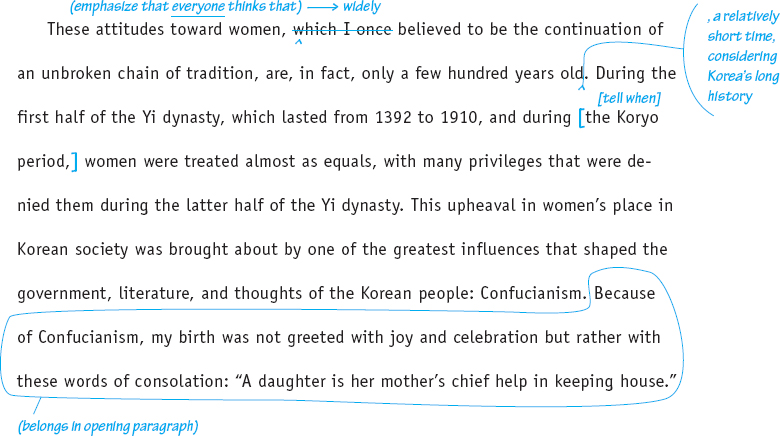Revising and Editing
For more revising and editing strategies, see Ch. 23.
Because explaining causes and effects takes hard thought, set aside plenty of time for rewriting. As Yun Yung Choi approached her paper’s final version, she wanted to rework her thesis for greater precision with more detail.
| WORKING THESIS | The turnabout for women resulted from the influence of Confucianism in all aspects of society. |
| REVISED THESIS | This turnabout in women’s place in Korean society was brought about by one of the greatest influences that shaped the government, literature, and thoughts of the Korean people — Confucianism. |
She also faced a problem pointed out by classmates: how to make a smooth transition from recalling her own experience to probing causes.

REVISION CHECKLIST
- Have you shown your readers your purpose in presenting causes or effects?
- Is your explanation thoughtful, searching, and reasonable?
- Where might you need to reorganize or add transitions so your paper is easy for readers to follow?
If you are tracing causes,
See more on evidence. See more on mistakes in thinking called logical fallacies.
- Have you made it clear that you are explaining causes?
- Do you need to add any significant causes?
- At what points might you need to add more evidence to convince readers that the causal relationships are valid, not just guesses?
- Do you need to drop any remote causes you can’t begin to prove? Or any assertions made without proof?
- Have you oversimplified by assuming that only one small cause accounts for a large outcome or that one thing caused another just by preceding it?
If you are determining effects,
- Have you made it clear that you are explaining effects?
- What possible effects have you left out? Are any of them worth adding?
- At what points might you need more evidence that the effects occurred?
- Could any effect have resulted not from the cause you describe but from some other cause?
See more editing and proofreading strategies.
After you have revised your cause-and-effect essay, edit and proofread it. Carefully check the grammar, word choice, punctuation, and mechanics — and then correct any problems you find.
EDITING CHECKLIST
See the relevant checklist sections in the Quick Editing Guide for more help. See also to the Quick Format Guide.
| Have you used correct verb tenses and forms throughout? When you describe events in the past, is it clear what happened first and what happened next? | A3 | ||
| Have you avoided creating fragments when adding causes or effects? (Check revisions carefully, especially those beginning “Because...” or “Causing...”) Have you avoided comma splices or fused sentences when integrating ideas? | A1, A2 | ||
| Do your transitions and other introductory elements have commas after them, if these are needed? | C1 |